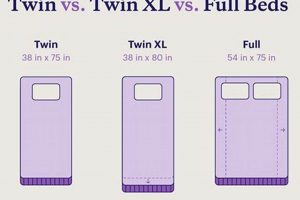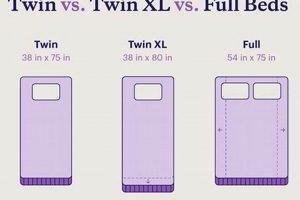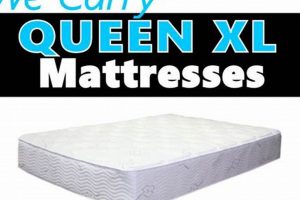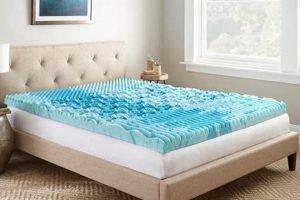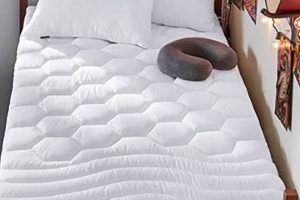Extra-long mattresses are characterized by dimensions exceeding the standard length of a twin or full-size bed. These mattresses offer increased length to accommodate taller individuals, preventing discomfort caused by hanging feet or cramped sleeping positions. An example would be a bed measuring 80 inches in length, typically categorized within this extended dimension group.
The significance of a longer sleep surface lies in promoting proper spinal alignment and ensuring adequate support throughout the body. This can lead to improved sleep quality and reduced pressure points, contributing to enhanced physical well-being. Historically, customized bedding solutions were often the only option for taller individuals; however, the availability of extended-length mattresses has made comfortable sleep more accessible.
Understanding the specific dimensions and benefits allows for informed decisions regarding sleep solutions. The subsequent sections will delve into various aspects such as comparing them to other mattress sizes, examining suitable bed frames, and providing guidance on selecting appropriate bedding and accessories.
Guidance on Extra-Long Mattress Selection
The following points provide key considerations for individuals in the market for mattresses of extended length, aiding in a selection process that aligns with personal needs and practical constraints.
Tip 1: Measure Available Space: Prior to purchase, accurately measure the dimensions of the intended bedroom space. This ensures adequate room for the mattress and surrounding furniture, preventing overcrowding and maintaining functionality.
Tip 2: Evaluate Individual Height: A mattress of extended length is primarily intended for taller individuals. Evaluate one’s height in relation to the mattress’s length to ensure ample space to avoid discomfort and promote proper spinal alignment.
Tip 3: Assess Frame Compatibility: Ensure existing or newly purchased bed frames are compatible with the specific dimensions. Mismatched frame sizes can compromise support and reduce the lifespan of the mattress.
Tip 4: Consider Sleeping Position: Different sleeping positions benefit from varying degrees of support and contouring. Investigate the mattress construction and materials to determine suitability for back, side, or stomach sleeping.
Tip 5: Research Material Properties: Familiarize oneself with the properties of different mattress materials, such as memory foam, innerspring, or latex. Each material offers unique characteristics regarding support, temperature regulation, and durability.
Tip 6: Review Warranty Terms: Carefully examine the warranty terms and conditions offered by the manufacturer. A comprehensive warranty provides protection against manufacturing defects and ensures recourse in the event of premature wear or failure.
Tip 7: Read Customer Reviews: Consult online reviews and testimonials from other customers to gain insights into the mattress’s long-term performance, durability, and overall satisfaction.
Selecting a mattress that accommodates extended length necessitates careful consideration of individual needs and practical factors. By evaluating spatial constraints, physical attributes, and mattress characteristics, individuals can make informed decisions that promote restful and supportive sleep.
The following section will provide a comparison between extra-long mattress dimensions and other standard mattress types to further inform the decision-making process.
1. Dimensions
The term “dimensions” in the context of mattresses refers to the specific measurements of length, width, and sometimes thickness. For extra-long mattresses, dimensions are paramount because the primary reason for selecting this type is to accommodate individuals who exceed the height limitations of standard mattress sizes. An inadequate length can lead to discomfort, improper spinal alignment, and disrupted sleep patterns. Conversely, appropriate dimensions ensure full body support, minimizing pressure points and promoting restful sleep. For example, if an individual is 6’4″ (76 inches) tall, an 80-inch extra-long mattress is a necessity, not a luxury, to prevent their feet from hanging off the edge and disrupting their sleep.
The impact of dimensions extends beyond mere length. The width must also be considered, ensuring adequate space for movement during sleep. A narrow extra-long mattress might restrict movement, especially for individuals who tend to toss and turn. Furthermore, the thickness, often correlated with mattress comfort and support, contributes to the overall sleep experience. A thicker mattress can provide greater cushioning and support, especially for heavier individuals. The practical application of this understanding lies in the ability to select a mattress that perfectly matches physical requirements and sleeping preferences.
In summary, the dimensions of an extra-long mattress are fundamental to its functionality and efficacy. Ignoring these measurements can negate the benefits of an otherwise high-quality sleep surface. Accurate assessment of individual height, sleeping habits, and the available space within the bedroom are critical steps in the selection process. Challenges may arise from the limited availability of extra-long mattresses in certain locations or the increased cost associated with specialized sizes. Nonetheless, the potential for improved sleep quality and long-term physical well-being justifies the careful consideration of dimensions when investing in this type of mattress.
2. Bed Frames
The compatibility between bed frames and mattresses of extended length is a fundamental consideration in ensuring proper support, safety, and longevity of both components. The physical dimensions of the mattress must correspond precisely with the internal measurements of the bed frame. A mismatch in size can lead to inadequate support, causing the mattress to sag or shift, which in turn compromises spinal alignment and reduces sleep quality. For instance, placing an extra-long mattress on a standard-sized frame will result in overhang and uneven weight distribution, accelerating wear and tear on the mattress and potentially damaging the frame itself.
The construction and materials of the bed frame also play a critical role. Solid wood frames or those with robust metal supports are better suited to withstand the increased weight and length of mattresses of extended size. Bed frames with insufficient support structures may bow or break under the additional stress. Furthermore, the style of the bed frame can impact functionality. Platform beds, which provide continuous support, are generally more suitable than frames with slats, unless the slats are closely spaced and adequately reinforced. A practical example includes selecting a heavy-duty platform bed with a weight capacity exceeding the combined weight of the mattress and occupants to ensure long-term stability.
The integration of a compatible bed frame with an extended-length mattress is essential for optimizing sleep quality and preserving the investment in both components. Failure to prioritize this compatibility can lead to discomfort, premature wear, and potential safety hazards. Awareness of dimensional requirements, material strength, and structural integrity are key to making informed decisions. Challenges may include the limited availability of bed frames specifically designed for extended-length mattresses or the higher cost associated with specialized support systems. However, the long-term benefits of proper support and mattress longevity justify the careful selection of a suitable bed frame.
3. Sleeping Position
The correlation between sleeping position and extra-long mattress dimensions is significant. Individual sleep preferences directly influence the required mattress length, width, and support characteristics. The following delineates specific facets of this correlation.
- Spinal Alignment and Side Sleeping
Side sleeping necessitates adequate mattress length to prevent spinal compression and ensure proper alignment from head to toe. Shoulders and hips require sufficient space to sink slightly into the mattress, while maintaining support for the waist. An extra-long mattress ensures that taller side sleepers are not forced into a fetal position due to length constraints, mitigating potential back pain and discomfort.
- Back Sleeping and Length Requirements
Back sleeping necessitates full body support, particularly along the spine. An individual’s height dictates the minimum required mattress length to avoid dangling feet. Extra-long mattresses cater to taller back sleepers, allowing for complete leg extension and minimizing pressure points along the spine. Proper length contributes to even weight distribution and reduces the risk of lower back strain.
- Stomach Sleeping and Body Support
Stomach sleeping, while generally discouraged due to potential spinal strain, requires specific considerations in mattress selection. Extra-long mattresses offer added length for stomach sleepers to comfortably stretch and reposition without falling off the edge. The surface should provide adequate support to prevent excessive sinking of the hips, which can exacerbate spinal misalignment. The mattress firmness is crucial for stomach sleepers.
- Restless Sleepers and Movement Space
Individuals who frequently change positions during sleep require ample space to accommodate their movements. An extra-long mattress provides the necessary length and width to allow for unrestricted repositioning. This is particularly beneficial for taller restless sleepers who risk hitting the headboard or footboard on a standard-sized bed. Expanded surface area contributes to undisturbed sleep throughout the night.
In conclusion, the selection of an appropriately sized mattress, particularly one of extended length, is inextricably linked to preferred sleeping positions. Tailoring the mattress dimensions and support characteristics to accommodate individual sleep habits is paramount to achieving optimal spinal alignment, pressure relief, and overall sleep quality. Prioritizing this alignment minimizes potential discomfort and promotes long-term physical well-being.
4. Material Density
Material density, a critical factor in mattress construction, directly impacts support, durability, and overall comfort, especially in larger sizes. The density of materials such as foam, latex, or innerspring coils dictates how well the mattress distributes weight and resists compression over time. In the context of extra-long mattresses, density assumes even greater significance due to the increased surface area and potential for higher weight loads.
- Support and Spinal Alignment
Higher density materials offer superior support, maintaining proper spinal alignment throughout the night. In an extra-long mattress, inadequate density can lead to sagging in the center or edges, compromising support and potentially causing discomfort or back pain. For instance, a high-density memory foam or latex core ensures that the mattress provides consistent support across its entire surface, crucial for taller individuals who require uniform weight distribution.
- Durability and Longevity
Material density directly correlates with the lifespan of a mattress. High-density materials are more resistant to compression and deformation, extending the mattress’s usable life. Extra-long mattresses, often subjected to higher and more distributed weight loads, benefit significantly from high-density construction. A low-density foam core may break down prematurely, leading to indentations and a loss of support, requiring replacement sooner than expected. Mattresses with density 5 lb/cubic foot or higher lasts longer than the others.
- Pressure Relief and Comfort
The ability of a mattress to relieve pressure points depends largely on the density of its comfort layers. High-density foams conform more closely to the body’s contours, distributing weight evenly and reducing pressure on sensitive areas such as hips and shoulders. In an extra-long mattress, this is especially important as individuals may shift positions more frequently or require targeted support in specific areas. A low-density foam layer may compress quickly, offering minimal pressure relief and leading to discomfort.
- Temperature Regulation
Material density influences airflow and heat retention within the mattress. High-density foams, particularly memory foam, tend to trap heat more readily than low-density alternatives. In extra-long mattresses, this can be a concern, especially for individuals who sleep hot. Choosing mattresses with open-cell foam structures or incorporating cooling technologies can mitigate this issue and enhance breathability, promoting a more comfortable sleep environment.
The interplay between material density and mattress dimensions is critical for ensuring optimal performance. A seemingly minor difference in foam or coil density can have significant ramifications for support, durability, and comfort, particularly in larger mattresses. Thorough consideration of these factors is essential for selecting an extra-long mattress that meets individual needs and provides lasting value.
5. Weight Capacity
Weight capacity is a critical specification for mattresses, especially those of extended length. It dictates the maximum combined weight a mattress can support without compromising structural integrity or performance. The weight capacity consideration is paramount for ensuring comfort, longevity, and optimal support.
- Support Structure and Weight Distribution
The internal support structure of a mattress, including the coil system or foam core, directly influences its ability to bear weight. An insufficient support structure will lead to sagging and uneven weight distribution, reducing comfort and potentially causing back pain. Extra-long mattresses, due to their larger surface area, require robust support to maintain consistent performance across the entire sleeping surface. For example, a mattress designed for a maximum weight of 500 pounds will likely perform poorly if subjected to a combined weight exceeding this limit, resulting in premature wear and tear.
- Material Density and Compression Resistance
The density of the materials used in mattress construction, such as foam or latex, affects their ability to resist compression under weight. Higher density materials offer greater resistance, allowing the mattress to maintain its shape and support over time. In extra-long mattresses, the concentration of weight in certain areas necessitates durable, high-density materials to prevent localized sagging. Mattresses made from low-density materials may compress significantly under weight, resulting in a loss of support and reduced comfort.
- Edge Support and Perimeter Stability
Edge support is essential for maintaining stability and preventing roll-off, especially in larger mattresses. Reinforced edges provide a firm perimeter that allows individuals to sit or sleep near the edge of the mattress without experiencing significant compression. Extra-long mattresses benefit from enhanced edge support to ensure a consistent sleeping surface across the entire mattress width. Inadequate edge support can create a feeling of instability and reduce the usable sleeping area.
- Warranty Implications and Load Limits
Exceeding the specified weight capacity of a mattress can void the manufacturer’s warranty. Warranties typically cover manufacturing defects and premature wear under normal use, but they do not extend to damage caused by exceeding the recommended weight limits. Consumers should carefully review the warranty terms and conditions to understand the weight capacity restrictions. The weight capacity specified in the mattress must be adequate for the heaviest person who will use the bed.
Considerations regarding weight limits must be prioritized when selecting a mattress of extended length. Neglecting this specification can compromise comfort, reduce durability, and potentially void the warranty, leading to dissatisfaction and premature replacement. In addition to weight the use of foundation must be considered, as using old or inappropriate foundation leads to decrease the life span of xl mattress.
6. Cost Analysis
A comprehensive cost analysis is crucial when considering the purchase of extra-long mattresses. This analysis extends beyond the initial purchase price to encompass factors affecting long-term value and affordability, allowing for an informed decision aligned with budgetary constraints and expectations.
- Initial Purchase Price vs. Long-Term Value
The initial purchase price of an extra-long mattress often exceeds that of standard sizes due to increased material requirements and specialized manufacturing processes. However, focusing solely on the upfront cost can be misleading. A higher-priced, high-quality extra-long mattress may offer superior durability, support, and comfort, resulting in longer-term cost savings by delaying replacement. For example, a mattress priced at $1500 with a lifespan of 10 years represents a lower annual cost than a $1000 mattress requiring replacement after 5 years.
- Material Composition and Pricing
The materials used in the construction of extra-long mattresses significantly influence their price. Mattresses incorporating premium materials such as natural latex, high-density memory foam, or advanced coil systems typically command higher prices. However, these materials often offer enhanced comfort, support, and longevity. Understanding the material composition and its associated benefits is essential for evaluating the price-to-value ratio. For instance, a mattress using CertiPUR-US certified foam may justify a higher price point due to its verified quality and safety standards.
- Bed Frame and Foundation Costs
Extra-long mattresses frequently require specialized bed frames and foundations to ensure adequate support and dimensional compatibility. These components represent additional expenses that must be factored into the overall cost analysis. Standard-sized bed frames are not suitable for extra-long mattresses, necessitating the purchase of appropriately sized frames, which may be less readily available and thus more expensive. For example, a custom-built bed frame for an extra-long mattress may cost $500 or more, impacting the overall budget.
- Shipping and Delivery Charges
Shipping and delivery charges can significantly impact the total cost of an extra-long mattress, particularly for online purchases. Due to their size and weight, these mattresses often incur higher shipping fees than standard sizes. Furthermore, specialized delivery services may be required to handle the larger dimensions, adding to the expense. Before finalizing a purchase, carefully review the shipping costs and consider alternative options, such as in-store pickup, to potentially reduce these charges. Some companies offer free shipping for larger mattresses, making them a more cost-effective option.
In summation, evaluating the cost of an extra-long mattress necessitates a holistic perspective that encompasses the initial purchase price, material composition, associated bed frame and foundation costs, and shipping fees. By considering these factors in tandem, consumers can make an informed decision that aligns with their budgetary constraints and long-term sleep needs.
Frequently Asked Questions
The following section addresses common inquiries regarding mattresses exceeding standard length dimensions. This aims to provide clear, concise information for informed decision-making.
Question 1: What defines an “extra-long” mattress size?
This category typically encompasses mattresses exceeding the standard length of a twin or full-sized bed. Dimensions frequently range from 80 inches (Twin XL) to 84 inches (California King), catering to taller individuals requiring additional legroom.
Question 2: Why would one choose an extra-long mattress?
The primary reason is to accommodate taller individuals, preventing discomfort caused by dangling feet or cramped sleeping positions. The mattress promotes proper spinal alignment, contributing to improved sleep quality and reduced pressure points.
Question 3: Are specialized bed frames required for these mattresses?
Yes, compatibility is crucial. Standard-sized frames are unsuitable, potentially leading to inadequate support, mattress sagging, and reduced lifespan. Ensure the chosen frame’s internal dimensions precisely match the mattress dimensions.
Question 4: Does material density affect the performance of these mattresses?
Material density significantly impacts support, durability, and comfort. Higher density materials offer superior weight distribution and compression resistance, essential for maintaining spinal alignment and preventing premature wear.
Question 5: What is the typical weight capacity of an extra-long mattress?
Weight capacity varies based on construction and materials. It is essential to verify the manufacturer’s specifications and select a mattress that adequately supports the combined weight of all occupants to prevent structural damage and ensure warranty validity.
Question 6: Do prices of extra-long mattresses differ significantly from standard sizes?
Generally, these mattresses command higher prices due to increased material requirements and specialized manufacturing. However, considering long-term value, durability, and potential health benefits is crucial in assessing affordability.
The above addresses key concerns regarding extended-length sleep surfaces. Knowledge of these points is paramount to guaranteeing optimal sleep quality.
The subsequent segment will offer a comparative evaluation of various extended-length mattress types, facilitating a thorough decision-making process.
Conclusion
This analysis has explored crucial facets of xl mattress size, encompassing dimensions, frame compatibility, sleeping position considerations, material density implications, weight capacity limitations, and overall cost analysis. A detailed understanding of these elements is paramount for informed selection, ultimately influencing sleep quality and physical well-being.
A judicious evaluation of personal needs and mattress specifications remains crucial. Failing to properly assess each aspect can lead to discomfort, premature wear, and compromised support. Individuals are encouraged to utilize the insights provided to make well-informed decisions, ensuring a sleep solution that promotes long-term health and optimal rest.


